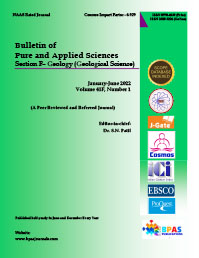Geomorphology and Morphometry of the Uttar Mand River Basin, Satara District, Maharashtra, India
DOI:
https://doi.org/10.48165/bpas.2023.42F.2.1Keywords:
Uttar Mand River Basin, Morphometric Parameters, Geomorphology, watershed management, Satara DistrictAbstract
In the present investigation various morphometric parameters of the Uttar Mand river basin are outlined. The Survey of India Toposheet numbers 47 G/15, 47 K/3 on the scale of 1: 50,000 were used for the present study. Stream ordering method as suggested by the Strahler has been employed. According to morphometric analysis of the Uttar Mand river basin, it is a fifth-order basin that is transitioning from an early mature to an older stage of the fluvial geomorphic cycle. The drainage pattern of the basin is dendritic in nature. A particular order's mean channel segment length is more than the next lower order but less than the next higher order. The relationship between stream order and mean stream length provides a group of points that lie roughly along a curve line, indicating that the area is not subject to severe structural influence.
Downloads
References
CGWB (2018) Generalized Geological sequence, Satara district. Aquifer Maps And Ground Water Management Plan.
Deshpande, G. G. (1998) Geology of Maharashtra, Publication Geol. Soc. of India. 167 p.
Deshpande, G. G. (1998) Geology of Maharashtra. Geological Society of India, Bangalore.)
GSI (2008) Geology and Mineral resources of Maharashtra 2008
Jean-Emmanuel Hurtrez, Francis Lucazeau (1999) Lithological control on relief and hypsometry in the Hérault drainage basin (France), Earth and Planetary Science, Volume 328, Issue 10.
Langbein, W.B. (1947) Topographic Characteristics of Drainage Basins. USGS Water Supply Paper, 947-C. 157 p.
Reddy, M. A. (2002) Textbook of Remote Sensing and Geographical Informationand drainage density (Dd). The Rn of the entire Uttar Mand River Basin is 1.29, indicating a Moderate basin relief. Such values are characteristic of Moderate elevation region (Schumn1956). The length of overland flow for Uttar Mand basin is 0.204 kilometre. The study area Uttar Mand watershed is characterized by altitudinal differences of 1105 m above sea level and 574 m above sea level maximum and minimum elevations respectively. Hypsometric integral is 0.37. It indicates an old stream as 37 percent of basin landmass is to be old stage of dissection.
System, BS Publications, Hyderabad, (2nd edi.), 23-27.
Schumm, S.A. (1956) Evolution of Drainage Systems & Slopes in Badlands at Perth, New Jersey. Bulletin of the Geological Society of America, 67, 597-646.
Singh, A. & Prakash, S.R. (2004) Integration of Thematic Maps through GIS for Identification of Groundwater Potential Zones, Proc. Vol. Map India, 47-54.
Strahler, A. (1952) Dynamic Basis of Geomorphology. Geological Society of America Bulletin, 63, 923-938.
Strahler, A. (1957) Quantitative Analysis of Watershed Geomorphology. Transactions, American Geophysical Union, 38, 913-920.
Strahler, A. (1964) Quantitative Geomorphology of Drainage Basins and Channel Networks. In: Chow, V., Ed., Handbook of Applied Hydrology, McGraw Hill, New York, 439-476.
Downloads
Published
Issue
Section
License

This work is licensed under a Creative Commons Attribution-NonCommercial-NoDerivatives 4.0 International License.



